Ultrasound-Assisted Syntheses of Chalcones: Experimental Design and Optimization †
Abstract
:1. Introduction
2. Methods
General Procedure for the Synthesis of (E)-1,3-Diphenyl-2-Propen-1-One
2.1.1. Conventional Method
2.1.2. Ultrasonic Assisted Synthesis
3. Results and Discussion
3.1. Taguchi´s Experimental Design
- The experiences were performed on two different days, in this way the non-controllable variables could be fixed, the humidity differed by 7%, the ambient temperature was controlled by a spatial heater and the volumetric material was separated into 2 groups (each group corresponded at one level).
- The choice of controllable variables was made taken into account: (a) the probe tip supports a 50% of maximum power, therefore was used 30% as top level and 10% (minimum of use) as the lower level. (b) In the instrument, the pulse mode applies ultrasonic energy to the tip at a rate of one pulse per second. The pulse duration can be adjusted from 10% to 90%, in our case; we decided to use levels above the 50%. (c) The levels of reaction time were chosen considering the lower times that can be used (Table 2 and Table 3). We applied 4 replicas for each test and each one was subjected to different external conditions. The fact of have made more than one replica per test allowed greater sensitivity to detect changes [22]. With each replica value, we have calculated de S/N ratio per experience.
3.2. ANOVA
3.3. Control Chart
4. Conclusions
Acknowledgment
References
- Chtourou, M.; Abdelhédi, R.; Hédi Frikha, M. Solvent free synthesis of 1, 3-diaryl-2-propenones catalyzed by commercial acid-clays under ultrasound irradiation. Ultrason. Sonochem. 2010, 17, 246–249. [Google Scholar] [CrossRef] [PubMed]
- Li, J.; Yang, W.-Z.; Wang, S.-X.; Li, S.-H. Improved synthesis of chalcones under ultrasound irradiation. Ultrason. Sonochem. 2002, 9, 237. [Google Scholar] [CrossRef] [PubMed]
- Bhuiyan, M.M.H.; Hossain, M.I.; Mahmud, M.M.; Al-Amin, M. Microwave-assisted efficient synthesis of chalcones as probes for antimicrobial activities. J. Chem. 2008, 1, 21–28. [Google Scholar]
- Syam, S.; Abdelwahab, S.I.; Al-Mamary, M.A.; Mohan, S. Synthesis of chalcones with anticancer activities. Molecules 2012, 17, 6179. [Google Scholar] [CrossRef] [PubMed]
- Climent, M.; Corma, A.; Iborra, S.; Velty, A. Activated hydrotalcites as catalysts for the synthesis of chalcones of pharmaceutical interest. J. Catalysis 2004, 221, 474–482. [Google Scholar] [CrossRef]
- Ballini, R.; Bosica, G.; Ricciutelli, M.; Maggi, R.; Sartori, G.; Sartorio, R.; Righi, P. Clay-catalysed solventless synthesis of trans-chalcones. Green Chem. 2001, 3, 178–180. [Google Scholar] [CrossRef]
- Sebti, S.; Solhy, A.; Tahir, R.; Boulaajaj, S.; Mayoral, J.A.; Fraile, J.M.; Kossir, A.; Oumimoun, H. Calcined sodium nitrate/natural phosphate: an extremely active catalyst for the easy synthesis of chalcones in heterogeneous media. Tetrahedr. Lett. 2001, 42, 7953–7955. [Google Scholar] [CrossRef]
- Fuentes, A.; Marinas, J.M.; Sinisterra, J.V. Catalyzed synthesis of chalcones under interfacial solid-liquid conditions with ultrasound. Tetrahedr. Lett. 1987, 28, 4541–4544. [Google Scholar] [CrossRef]
- Climent, M.J.; Corma, A.; Iborra, S.; Primo, J.J. Base catalysis for fine chemicals production: Claisen-Schmidt condensation on zeolites and hydrotalcites for the production of chalcones and flavanones of pharmaceutical interes. J. Catal. 1995, 151, 60–66. [Google Scholar] [CrossRef]
- Saravanamurugan, S.; Palanichamy, M.; Arabindoo, B.; Murugesan, V. Liquid phase reaction of 2′-hydroxyacetophenone and benzaldehyde over ZSM-5 catalysts. J. Mol. Catal. A Chem. 2004, 218, 101–106. [Google Scholar] [CrossRef]
- Bing, W.; Wei, M. Recent advances for solid basic catalysts: Structure design and catalytic performance. J. Solid State Chem. 2019, 269, 184–194. [Google Scholar] [CrossRef]
- Li, J.; Yang, W.-Z.; Wang, S.-X.; Li, S.-H. Improved synthesis of chalcones under ultrasound irradiation. Ultrason. Sonochemestry 2002, 9, 237–239. [Google Scholar] [CrossRef] [PubMed]
- Bhuiyan, M.; Hossain, M.; Mahmud, M.; Al-Amin, M. Microwave-assisted Efficient Synthesis of Chalcones as Probes for Antimicrobial Activities. Chem. J. 2011, 1, 21–28. [Google Scholar]
- Palleros, D.R.J. Solvent-Free Synthesis of Chalcones. Chem. Educ. 2004, 81, 1345. [Google Scholar] [CrossRef]
- Polo, E.; Ibarra-Arellano, N.; Prent-Peñaloza, L.; Morales-Bayuelo, A.; Henao, J.; Galdámez, A.; Gutiérrez, M. Ultrasound-assisted synthesis of novel chalcone, heterochalcone and bis-chalcone derivatives and the evaluation of their antioxidant properties and as acetylcholinesterase inhibitors. Bioorg. Chem. 2019, 90, 103034. [Google Scholar] [CrossRef] [PubMed]
- BANDELIN Electronic. Sonoplus Manual; BANDELIN Electronic GmbH & Co. KG: Berlin, Germany, 2000. [Google Scholar]
- QSonica. Sonoplus Manual; QSonica: Newtown, CT 06470, USA, 2000. [Google Scholar]
- Neville, A.; McDougall, B. Erosion–and cavitation–corrosion of titanium and its alloys. Wear 2001, 250, 726–735. [Google Scholar] [CrossRef]
- Suwito, H.; Jumina, M.; Pudjiastuti, P.; Fanani, M.; Kimata-Ariga, Y.; Puspaningsih, N. Design and synthesis of chalcone derivatives as inhibitors of the ferredoxin—Ferredoxin-NADP+ reductase interaction of plasmodium falciparum: Pursuing new antimalarial agents. Molecules 2014, 19, 21473–21488. [Google Scholar] [CrossRef] [PubMed]
- Humberto Gutiérrez Pulido, M.O. Análisis y Diseños de Experimentos; McGraw-Hill: New York, NY, USA, 2008; p. 4. [Google Scholar]
- Mitra, A. Fundamentals of Quality Control and Improvement; Wiley-Blackwell: Hoboken, NJ, USA, 2016. [Google Scholar]
- Hernández, A. Apuntes de Diseño de Experimentos Taguchi; Universidad Nacional de Sur (UNS): Bahía Blanca, Argentina, 2015. [Google Scholar]
- Gopalsamy, B.M. Taguchi method and ANOVA: An approach for process parameters optimization ofhard machining while machining hardened steel. J. Sci. Ind. Res. 2009, 68, 686–695. [Google Scholar]
- ASTM. Manual on Presentation of Data and Control Chart Analysis; Neubauer, D., Ed.; ASTM: West Conshohocken, PA, USA, 2010. [Google Scholar]
- Anastas, P.T.; Warner, J.C. Green Chemistry: Theory and Practice; Oxford University Press: New York, NY, USA, 1998; Volume 19, pp. 21473–21488. [Google Scholar]
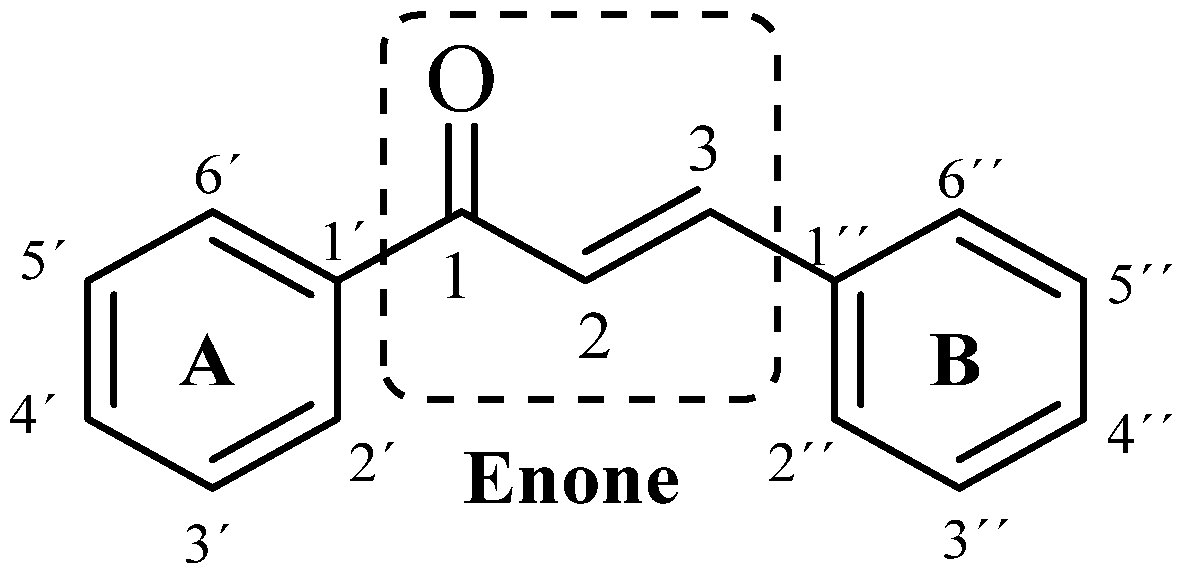

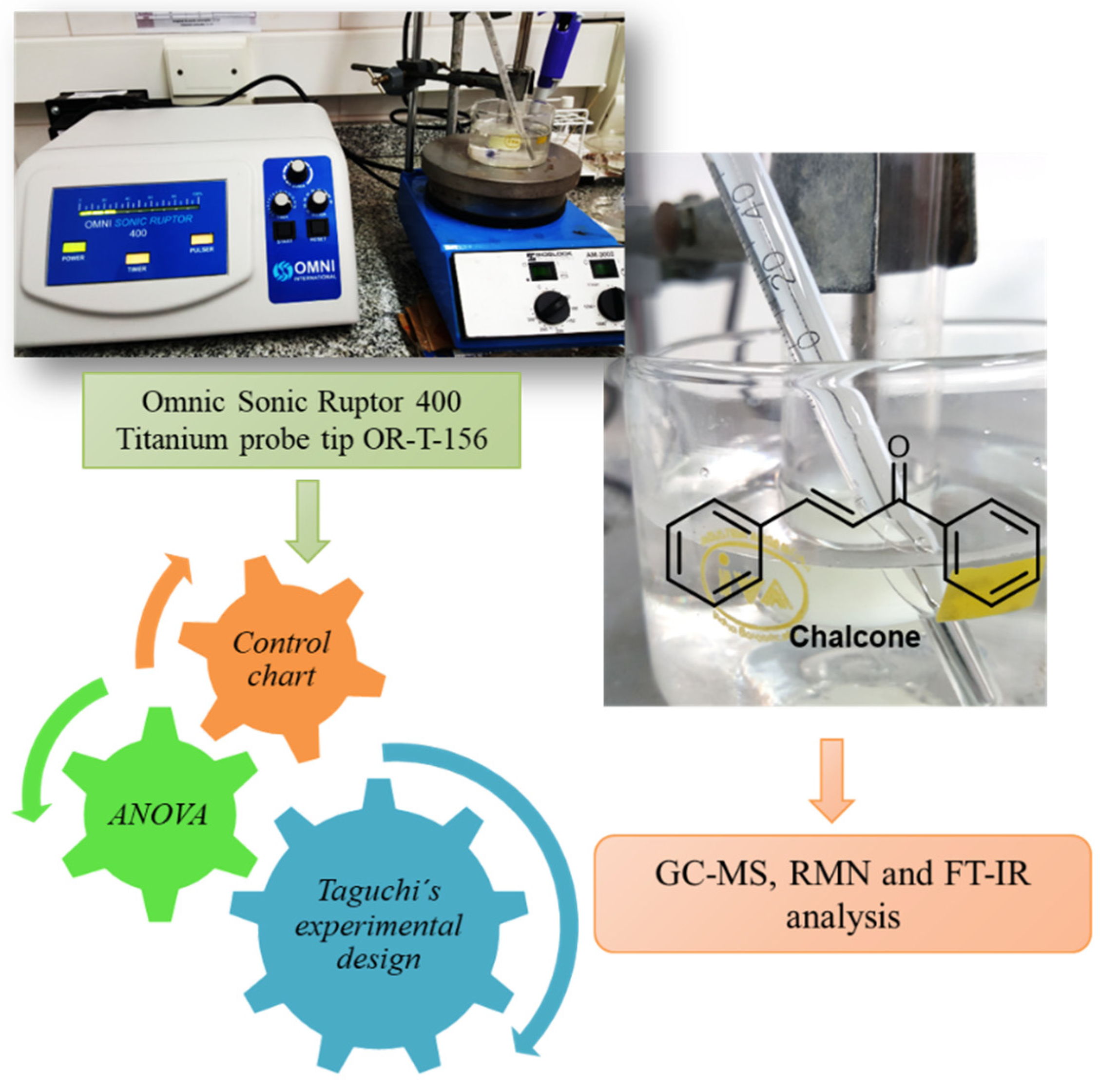
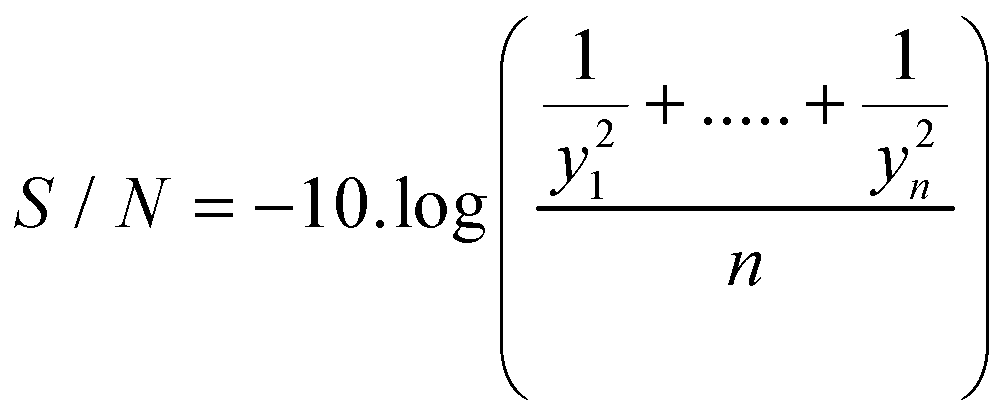
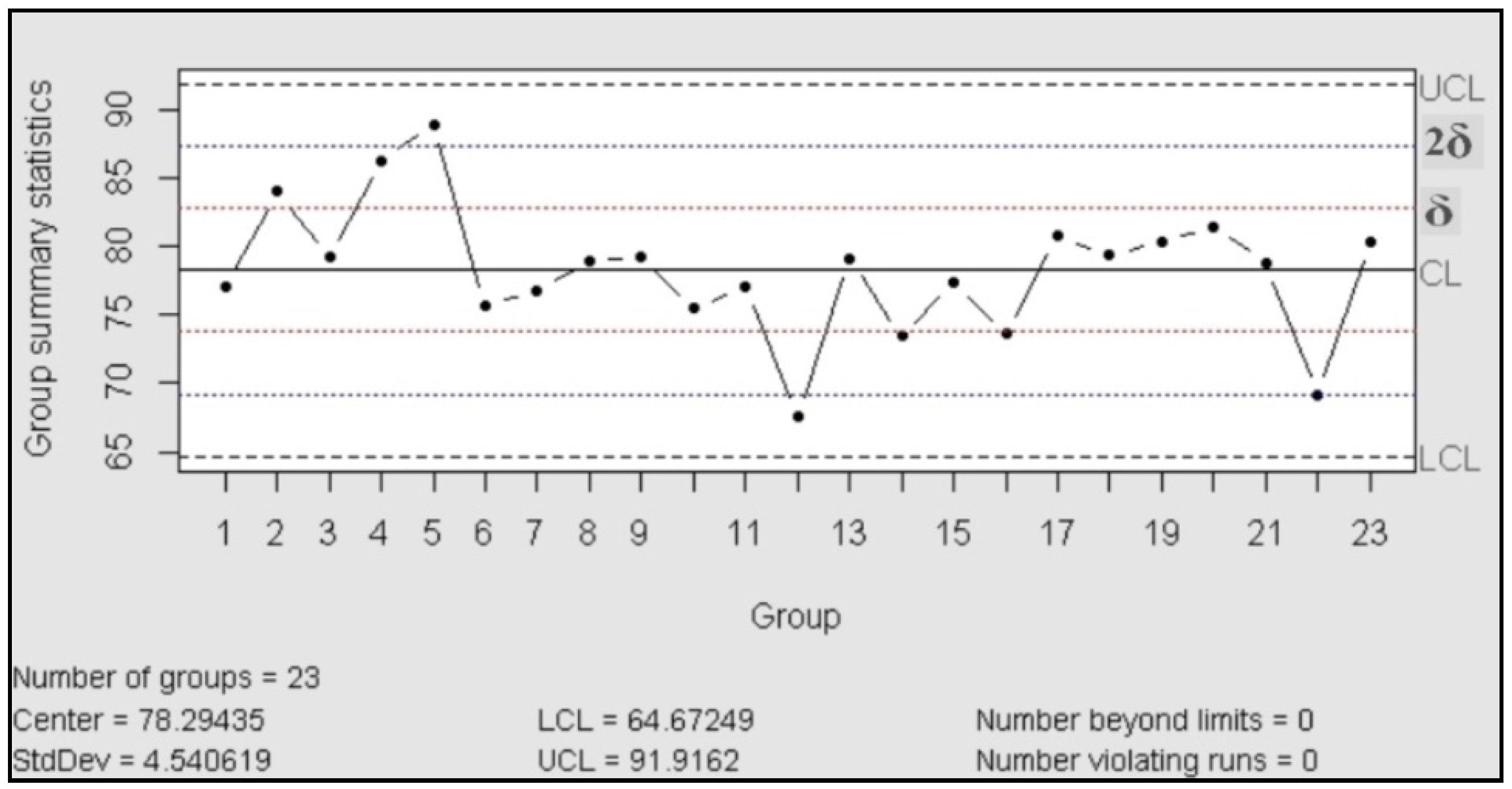
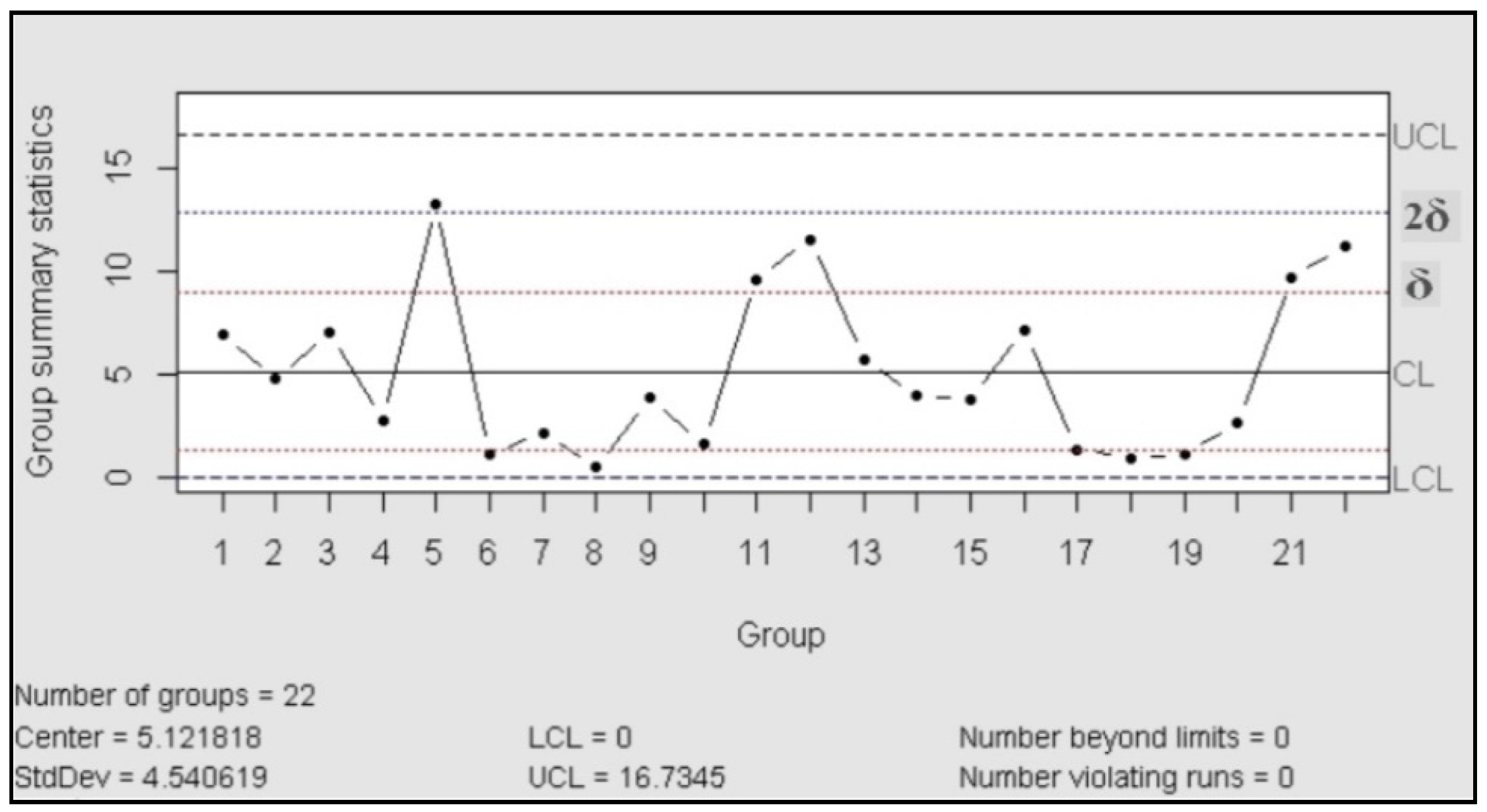
| K | 1 | 2 | 2 | 1 | |||
| L | 1 | 2 | 1 | 2 | |||
| M | 1 | 1 | 2 | 2 | |||
| Factor | A | B | C | Results (%) | |||
| Assay | |||||||
| 1 | 1 | 1 | 1 | Y1.1 | Y1.2 | Y1.3 | Y1.4 |
| 2 | 1 | 2 | 2 | Y2.1 | Y2.2 | Y2.3 | Y2.4 |
| 3 | 2 | 1 | 2 | Y3.1 | Y3.2 | Y3.3 | Y3.4 |
| 4 | 2 | 2 | 1 | Y4.1 | Y4.2 | Y4.3 | Y4.4 |
| Controllable Factors | Level | |
|---|---|---|
| 1 | 2 | |
| A (power) | 30% | 10% |
| B (pulse) | 80% | 60% |
| C (time) | 30’ | 5’ |
| Noise Factors | Level | |
|---|---|---|
| 1 | 2 | |
| K (Ambient Temperature) | 25 °C | 19 °C |
| L (Ambient Humidity) | 60% | 53% |
| M (Volumetric Material) | 1 | 2 |
© 2020 by the authors. Licensee MDPI, Basel, Switzerland. This article is an open access article distributed under the terms and conditions of the Creative Commons Attribution (CC BY) license (http://creativecommons.org/licenses/by/4.0/).
Share and Cite
Cancio, N.; Costantino, A.R.; Silbestri, G.F.; Pereyra, M.T. Ultrasound-Assisted Syntheses of Chalcones: Experimental Design and Optimization. Proceedings 2019, 41, 13. https://doi.org/10.3390/ecsoc-23-06475
Cancio N, Costantino AR, Silbestri GF, Pereyra MT. Ultrasound-Assisted Syntheses of Chalcones: Experimental Design and Optimization. Proceedings. 2019; 41(1):13. https://doi.org/10.3390/ecsoc-23-06475
Chicago/Turabian StyleCancio, Nicolás, Andrea R. Costantino, Gustavo F. Silbestri, and Marcelo T. Pereyra. 2019. "Ultrasound-Assisted Syntheses of Chalcones: Experimental Design and Optimization" Proceedings 41, no. 1: 13. https://doi.org/10.3390/ecsoc-23-06475
APA StyleCancio, N., Costantino, A. R., Silbestri, G. F., & Pereyra, M. T. (2019). Ultrasound-Assisted Syntheses of Chalcones: Experimental Design and Optimization. Proceedings, 41(1), 13. https://doi.org/10.3390/ecsoc-23-06475





